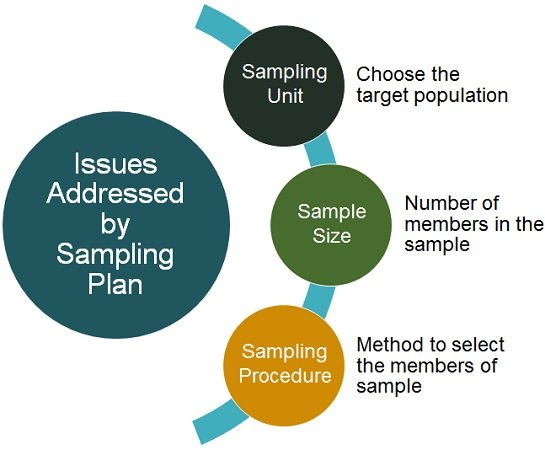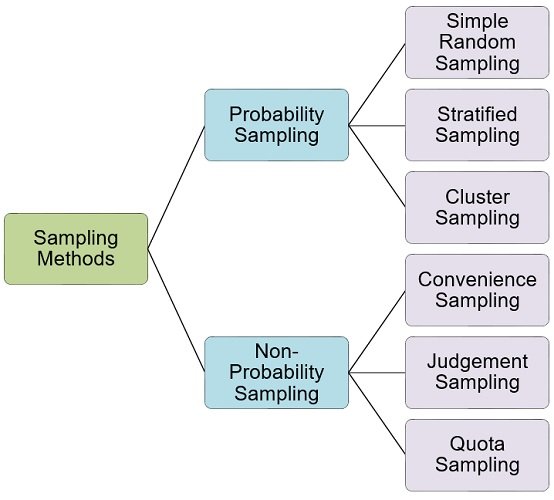Definition: A sampling plan provides an outline based on which the researcher performs research. Also, it provides a sketch required for ensuring that the data gathered is a representation of the defined target population. It is widely used in research studies. A researcher designs a sampling plan to prove that the data collected is valid and reliable for the concerned population.
It explains which category the researcher chooses for the survey. Also, it states the right sample size. Additionally, it expresses how the researcher has to be selected out of the population.
Issues Addressed by Sampling Plan
A sampling plan is the base from which the research starts. It includes the following three major decisions:
Sampling Unit
The researcher decides what the sampling unit should be. It involves choosing the category of the population to be surveyed. It defines the specific target population.
Example:
In the Banking industry, the researcher decides: what should the sampling unit include. It may cover current account holders, saving account holders, or both.
The researcher takes such decisions at the time of designing the sampling frame. They do so to give all the elements of the target population an equal chance of getting included in the sample.
Sampling unit
The researcher has to determine the sample size. This means how many objects in the sample the researcher will survey. Generally, “the larger the sample size, the more is the reliability”. Therefore, researchers try to cover as many samples as possible.
Sampling Procedure
Which method should the researcher use to perform sampling? For that, he must ensure that all the objects of the population have a fair and equal change of selection. Generally, researchers use probability sampling for determining the objects for selection. This is because probability sampling represents the sample more accurately.
In this regard, we are going to learn the two sampling methods:
Probability Sampling
- Simple Random Sampling: In this, every item of the sample has an equal chance of getting selected.
- Stratified Sampling: Here, the researcher divides the population into mutually exclusive groups, viz., age group. After that, the researcher will choose the elements randomly from each group.
- Cluster Sampling: Another name for cluster sampling is area sampling. In this, the researcher divides the population into existing groups or clusters. After that he chooses a sample of clusters on a random basis from the population.
However, the researcher usually finds probability sampling costly and time-consuming. In such a case, he can make use of non-probability sampling. It is a sampling by means of choice.
Non-Probability Sampling
- Convenience Sampling: Here, the researcher selects the easiest and most accessible population member.
- Judgment Sampling: Here, the researcher selects those members of the population whom he thinks that will contribute accurate information.
- Quota sampling: Here, the researcher interviews the fixed number of members of each category.
Thus, a researcher can select any kind of sample as per his convenience, subject to it fulfilling the purpose for which research takes place.
Steps involving Sampling Plan
An ideal sampling plan covers the following steps:
Define the target population
First of all, the researcher needs to decide and identify the group or batch for the study. The target population must be alloted identity by using descriptors. These descriptors indicate the characteristics of the elements. This will depict the target population frame.
Choose the data collection method
The researcher must choose a method for collecting the necessary data from the target population elements. For this, he uses information problem definition, data requirements and set research objectives.
Find out the sampling frames required
Once the researcher decides whom or what should be evaluated. The next step is to bring together a list of eligible sampling units. This list must have enough information about each prospective sampling unit. This allows the researcher can communicate with them. An incomplete sampling frame decreases the possibility of drawing a representative sample.
Pick the suitable sampling method
The researcher needs to pick any of the two types of sampling methods. The methods are probability and non-probability sampling. Usually, probability sampling yields better results. Also, it provides valid information about the target population’s criteria.
Ascertain necessary sample sizes and contract rates
The researcher must consider how accurate the sample estimates must be. Also, he needs to take into account how much time and money are available to collect data. To decide the right size of the sample, the researcher has to make the following decisions:
- Variability of population characteristics that is undergoing investigation.
- The confidence level is desired in the estimates.
- Degree of precision needed to estimate the population characteristic.
Design an operating plan for choosing the sample units
The researcher will design the actual procedures to use. He must include all the prospective respondents who form part of the sample.
Execute the operational plan
Carrying out data collection activities. This may involve actually talking to the prospective respondents by way of a telephone interview.
A word from Business Jargons
A sampling plan states the procedure for determining when the group under study is to be accepted or rejected. Further, if the sample gets rejected, the researcher must integrate corrective measures. He should do so after the complete inspection. After that, replacement of defective items with good ones takes place. We call this process a rectifying inspection.




nimisha says
The content was helpful